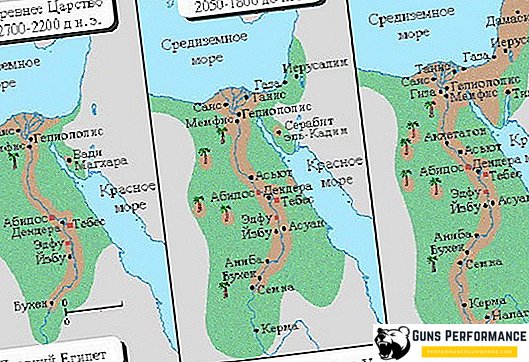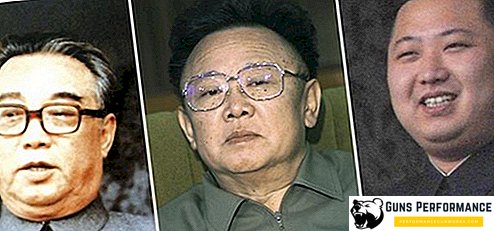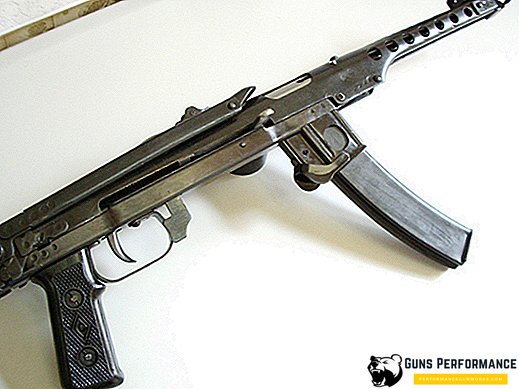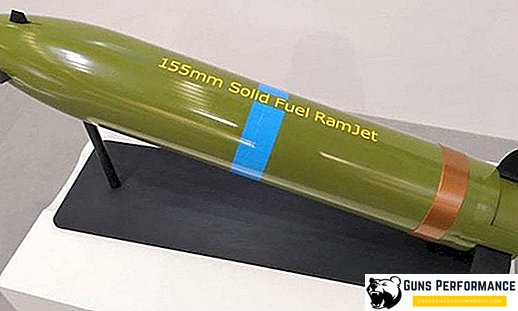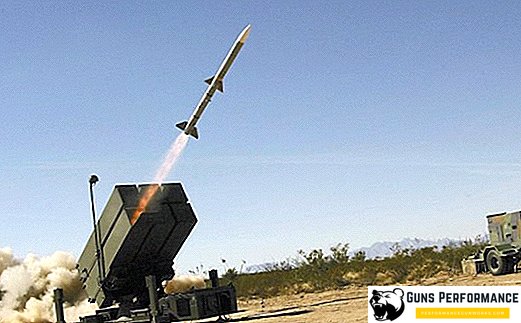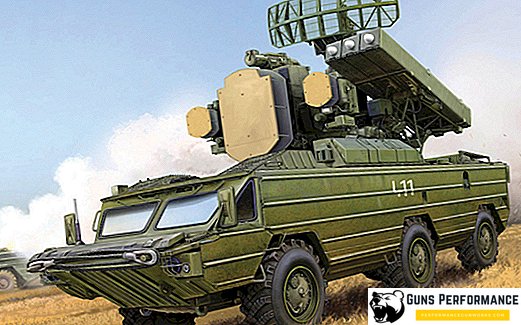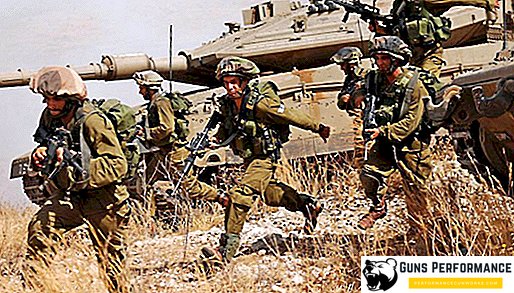
After the end of World War II, the Middle East became the main center of global instability for many decades. Over the last seven decades, more than a dozen full-scale wars have happened in this region, and tens and hundreds of thousands have been killed in these. And this is not counting the small conflicts, which for some reason are called “police” operations, while closing their eyes to the massive use of combat aircraft and armored vehicles in them.
Most of the Middle East conflicts of the second half of the 20th century and the beginning of this century, in one way or another, were associated with Israel, a state that appeared on the political map of the world only in 1948. Since its inception, the Jewish state constantly had to fight - the very next day after independence was declared, troops of five Arab states invaded its territory. And ... were completely broken.

Throughout its short history, Israel was like a besieged fortress surrounded by hostile neighbors, some of whom made the task of physically destroying the Jewish state their official ideology. Regular rocket attacks, terrorist acts, intifada and kidnapping is a reality in which Israelis have to live. Almost a quarter of the state budget is spent on defense, all citizens of the country, including girls, are subject to military conscription. Israel is constantly at the forefront - it is a real outpost of the Western world in the region.

The population of Israel is slightly more than 8 million people, it is surrounded by about 200 million Muslims. At first glance, this correlation of forces looks absolutely hopeless for the weaker side, but in the case of the Israeli army, ordinary logic stops working. The soldiers of the IDF (Tsakhal) won always and everywhere. In the history of the Israeli army were tactical failures, but there is not a single strategic defeat. Otherwise, the state of Israel would most likely cease to exist altogether.
But the opposite happened: as a result of the successful campaigns, the territory of Israel doubled. The right to existence of the Jewish state was brilliantly confirmed.

Today, the IDF is considered the most powerful armed forces in the region. Moreover, there is little doubt that Israel is a nuclear state, although the official Tel Aviv strongly denies having weapons of mass destruction. At present, the Israeli army is considered one of the most efficient armed forces on the planet.
However, before turning to the description of the Israel Defense Forces, a few words should be said about the history of the IDF, which is inextricably linked with the history of the state, which it so valiantly defended.
Story
The history of the Israeli army began even before the foundation of the Jewish state in the Middle East, in the 20s of the last century. After the appearance of the first Jewish settlements on the lands of Palestine, self-defense combat detachments were formed, which defended the Israelis from the Arab thugs. By the time of the beginning of the Second World War, they had strengthened sufficiently and had become a serious force in the region, which not only Muslims were forced to reckon with, but also the British, who formally ruled Palestine.
On May 14, 1948, the independence of Israel was proclaimed, and the very next day five Arab countries (Egypt, Syria, Iraq, Jordan, Lebanon) declared war on the newly created state. Today in Israel it is called the “War of Independence”. The Arabs call this conflict much more eloquently - "Catastrophe". It should be noted that the hostilities in Palestine began in 1947 and were conducted by Jewish and Arab militarized organizations.

On May 26, 1948, the head of the Provisional Government, David Ben-Gurion, signed a decree on the establishment of a national armed forces - the IDF. It consisted of all militarized underground Jewish organizations: "Hagana", "Etzel" and "Lehi".
During this war, the Jews were not only able to defend the independence of their state, but also significantly expand its borders. The “war of independence” led to a mass flight from the territory of Palestine of the Arab population, at the same time about 800 thousand Jews were expelled from Muslim countries and mostly settled in Israel.

For a long time, no one is surprised at the high level of equipment of the Israeli army, today the IDF’s armament is one of the most modern and advanced in the world. But it was not always so. During the War of Independence, the Israel Defense Forces experienced an acute shortage of weapons (especially modern ones) and ammunition. Jews had to use outdated weapons of the Second World War or establish handicrafts.

In 1956, the Suez War broke out between Israel and Egypt, which ended in March 1958 with the complete victory of the Jewish state. This conflict did not lead to territorial changes from the opposing sides.

Ten years later (in 1967), the so-called Six-Day War began between Israel and the Arab coalition consisting of Egypt, Syria, Algeria, Iraq and Jordan. It also ended in complete victory for the IDF, with Israeli aviation playing a key role in it. The Arab air forces were destroyed in just a few hours, after which the coalition ground troops were defeated within six days. Thanks to this victory, Israel annexed the Golan Heights, the Gaza Strip and the Sinai Peninsula, as well as the west coast of Jordan.

The so-called Doomsday War, which began on October 6, 1973, became the fourth Arab-Israeli conflict. It began with a surprise attack by the combined Syrian-Egyptian troops in the area of the Sinai Peninsula and the Golan Heights. The suddenness of the strike (Israeli intelligence "overslept" him) allowed the Arabs to seize the initiative and at first achieve significant success. However, later the Israelis regrouped and completely ousted the enemy from the Golan Heights, and in Sinai they managed to encircle the whole Egyptian army. After this, a UN resolution on a cease-fire was adopted.

In this conflict, both sides suffered heavy losses, although the number of dead and wounded by the Arab coalition was several times greater. A similar picture was observed with respect to the loss of armored vehicles and aircraft.
The Doomsday War can be called one of the most difficult trials for Israel and its armed forces. In the course of this conflict there were several moments when the situation, as they say, "hung in the balance" and could swing in any direction. The Arabs concluded from the defeat of 1967 and this time they were prepared much better.

The Doomsday War had serious political consequences, both within Israel and far beyond its borders. It led to the resignation of the government of Golda Meir, as well as the introduction by the OPEC member countries of an embargo on the supply of oil to Western countries, which raised its price three times.

In 1982, the first Lebanese war began, during which Israeli troops invaded Lebanese territory in order to defeat the Palestine Liberation Organization, behind which stood Syria and the Soviet Union. The IDF occupied the southern part of Lebanon and remained there until 2000.

Of great interest are the actions of the Israeli aviation (Operation Medvedka 19), which, thanks to the new tactics, managed in the shortest possible time to destroy the most powerful Syrian air defense in Lebanon, practically without incurring losses.

If we talk about the Israeli Air Force, we should recall the operation "Opera", conducted in 1981. Its goal was to destroy a nuclear reactor in Iraq, which could be used by Saddam Hussein to make weapons of mass destruction. As a result of the air raid, the reactor was destroyed, and the Israeli side suffered no losses.
In 2006, the Israelis again had to wage war in Lebanon. This time, their opponent was the radical Shiite organization Hezbollah, which many countries consider to be terrorist.
It was preceded by several operations against Hezbollah fighters and Palestinian Arab uprisings in the Gaza Strip and in the West Bank. As a rule, every few years the IDF has to conduct more or less major operations against Hamas or Hezbollah.
IDF: general information
The military doctrine of Israel was developed almost immediately after independence, in 1949. This document very clearly reflects the geopolitical realities in which the young Jewish state found itself.

In particular, it said that Israel will always wage war against an enemy that exceeds its number. At the same time, the reason for any future conflict was not territorial disputes, but the fact of rejection of the very existence of the Jewish state in the region. Also, the country's military doctrine absolutely rightly pointed out the fact that it was impossible for Israel to wage a long war, because it can simply bury the country's economy. The area of the country and its configuration deprives the Jewish state of its strategic depth, and the lack of natural boundaries for defense makes defense against the aggressor even more difficult.
All of the above theses have been repeatedly confirmed in the course of subsequent multiple conflicts.

Serving in the army of Israel is a draft, all citizens of the country, both boys and girls over 18 years old, are obliged to serve in it. For boys, her term is three, and for girls - two years.
Married women, men for health reasons, as well as those who came to the country over the age of 26 are exempted from conscription. Girls (for religious reasons) can go to alternative service, but this step is not very popular among Israeli youth. Orthodox Jews (men) may receive a reprieve for graduation (it may last for many years), but they often refuse such a right and serve in the army. In some cases (for example, for gifted students) there is also a delay to complete the training.
After the end of military service, servicemen are transferred to the reserve, which remains up to 45 years. Reservists are held annually for which any military liable up to 45 days can be called.
After completion of military service, a soldier may enter into a contract. Contractors occupy most of the command and administrative positions of the Israeli army.

The main difference between the IDF and most other armies in the world is the obligatory military duty for women. Israelis were forced to take such a step not from a good life. He allowed more men to be released for military service in order to somehow compensate for the numerical superiority of his opponents. Girls serve in all kinds of troops, but rarely participate in combat operations. About a third of women for various reasons (family, pregnancy, religious motives) are generally exempted from service.

Women more or less actively participated in the hostilities only during the 1948 War of Independence. But then the situation of the Israeli state was critical.
The citizens of Israel of Jewish and non-Jewish origin are called up for military service. They are happy to serve the Druze, their number among the military is quite large when compared with the total number of this ethno-confessional group. They are very keen on taking Bedouins to the IDF; they are very much appreciated as experienced trackers and scouts. In general, Muslims and Christians can enter the ranks of the armed forces as volunteers.
The structure of the Israeli army
The Israeli Defense Forces include three types of troops: naval, air force and ground. In general, the armed forces are subordinate to the Ministry of Defense, which develops defense policy, is engaged in strategic planning, oversees the development, procurement and production of weapons, solves a host of other administrative issues. It should be noted, the Israeli Ministry of Defense is the richest agency in the country.
The operational headquarters of the army is handled by the General Staff, which consists of six directorates. Each branch of the military has its own command.

The territory of the country is divided into three military districts: Southern, Central and Northern. After the first war in the Persian Gulf, rear control was created, its tasks include civil defense. The direct leadership of the troops rests precisely with the command of the districts, the command of the arms of the armed forces perform mainly administrative functions.
It should be noted that the management of military units is carried out through the communication system and the transfer of tactical information CAYAD ("Digital Army"). Israel is one of the few armies on the planet that in practice uses the technology of network-centric warfare.
It is very difficult to say the exact number of the Israel Defense Forces, as well as to say how many units of military equipment are in service with it. Most often in open sources as the total number is called the figure of 176 thousand people. These are military personnel on fixed or extra-long service. They should add another 565 thousand people reserve. The total mobilization resource of the country is 3.11 million people, of which 2.5 million are suitable for military service.
Israeli Ground Forces
The army of Israel is made up of ground troops, they consist of 2 armored, 4 infantry divisions, 15 tank, 12 infantry and 8 airmobile brigades. The structure and strength of these units may vary depending on the operational environment.

According to the data of The Military Balance (2016), in the armament of the Israeli ground forces there are: 220 Merkava-4 tanks, 160 Merkava-3 tanks and 120 Merkava-2 tanks. This combat vehicle is considered one of the best main battle tanks in the world, moreover, it was designed specifically for the Middle East theater of operations. In addition to the Merkav, outdated models of armored vehicles are also in operation, such as M60A1 / 3 (711 units), T-55 (more than a hundred), T-62 (more than a hundred), "Magah-7" (111 units), M -48 (568 pieces). Data on outdated armored vehicles refer to 2011, and it is likely that their number has now changed somewhat.
Also, as of 2018, the IDF had about 500 M113A2 armored vehicles (made in the USA), 100 Namer armored personnel carriers, 200 Ahzarit armored personnel carriers, 400 Nagmahon armored personnel carriers and 100 Ze'ev wheeled armored personnel carriers. All of the above equipment has been designed and manufactured in Israel. Separately, mention should be made of the RBY-1 RAMTA wheel reconnaissance vehicle (300 pieces) and the RCBZ TPz-1 Fuchs NBC reconnaissance vehicle manufactured in Germany (8 units).

The artillery units are equipped with: 250 ACS M109A5 (USA), 250 81-mm self-propelled mortars based on the M113, developed jointly with the Americans, 120-mm self-propelled mortar Keshet and the American MRL 702 MLRS (30 installations). Separately, Israeli salvo-fire systems should be mentioned, in the development of which the country's military-industrial complex has shown significant success in recent years. MLRS Lynx is a salvo fire system that can fire missiles of different caliber (122 mm, 160 mm and 300 mm), and can also be used as a launcher for Delilah-GL cruise missiles and LORA ballistic missiles. The exact number of such complexes that are in service with the Israeli army is unknown.

Of the anti-tank weapons that the IDF exploits, we should mention the Spike third-generation anti-tank systems, as well as the Pereh and Tamuz self-propelled anti-tank missile systems and the MAPATS portable anti-tank systems. The number of complexes in service with the Israeli army is unknown.

The Israeli ground forces use the Machbet ZSU (20 units) and Stinger anti-aircraft missiles as weapons of air defense.
Much attention in the IDF is paid to reconnaissance drones, the Israeli military-industrial complex is far advanced in this direction, Israel’s UAVs are actively exported and are considered among the best in the world.
Israeli navy
The Israeli naval forces are headed by the commander in the rank of vice admiral, the naval command includes five directorates, which are divided into departments.
The Israeli Navy has three bases: in Haifa, in Eilat and Ashdod, and several bases.

The Israeli Navy’s combat strength includes five diesel-electric submarines of the Dolphin type, built in Germany, three Saar-5 corvettes built in the USA, Saar 4.5 and Saar 4 missile boats, and patrol boats of various types.
As part of the Israeli fleet, there is a special unit, Shiyet 13 (13th Fleet Naval Flotilla), designed to conduct operations in the enemy's rear. It is considered one of the most elite and combat-ready and the IDF. The staff, composition and activities of the 13th Flotilla are carefully classified.

Israeli Air Force
The Israelis are proud of their air force, and for good reason. The Israeli Air Force is considered the most efficient not only in its region, but throughout the world.

IDF military aviation is divided into several types: tactical, air defense fighter, transport and reconnaissance. In the Israeli Air Force serves 33 thousand people. There are 57 airfields in the country.
Во главе военно-воздушных сил Израиля находится командующий в звании генерал-майора, с мая 2012 года эту должность занимает Амир Эшель.
Основу воздушной мощи Израиля составляют американские истребители F-15 и F-16 различных модификаций. Данные об их количестве сильно разнятся. Согласно данным на 2014 год, в распоряжении ВВС Израиля имеется: 53 F-15 (19 самолетов модификации A, 6 - B, 17 - C, 11 - D; еще некоторое количество F-15А находится на хранении), 25 единиц F-15I, и 278 F-16 (44 машин модификации A, десять - B, 77 - C, 48 - D, 99 - I).

На хранении также находятся устаревшие истребители: более сотни американских F-4Е и восемь разведчиков RF-4Е, 60 "Кфир" собственного производства. Следует упомянуть и американские штурмовики - новейшие противопартизанские АТ-802F (восемь единиц) и 26 старых A-4N.
ВВС Израиля располагает семью разведчиками RC-12D, двумя самолетами РЭБ "Гольфстрим-550", а также 11 самолетами-заправщиками: 4 КС-130Н и 7 КС-707 и 70 транспортными самолетами.
Среди учебных самолетов следует отметить 17 немецких Grob-120, 20 американских Т-6А и 20 учебно-боевых TA-4, а также один новейший итальянский М-346 (по другим данным их восемь).

Основными ударными вертолетами армии Израиля являются американские машины АН-64 "Апач" и АН-1 "Кобра" (примерно по 50 вертолетов каждого типа). Транспортные и многоцелевые вертолеты представлены следующими машинами: 19 (по другим данным 48) ОН-58В, 10 СН-53А, 39 S-70A, десять UH-60A. Для проведения морского патрулирования используется вертолет Eurocopter Panther (5 или 7 единиц).

ВВС Израиля начали получать новейшие американские истребители пятого поколения F-35 Lightning II. Всего заказано двадцать подобных машин. Есть информация, что "Лайтинги" уже применялись для нанесения ударов по территории Сирии, причем ни сирийская, ни российская ПВО не смогли воспрепятствовать этому.

Ядерное оружие
Израиль никогда официально не подтверждал (впрочем, и не опровергал тоже) факт наличия у него оружия массового поражения. Однако большинство экспертов считает, что ядерное оружие у армии Израиля все-таки есть, споры ведутся вокруг количества боеголовок и характеристик средств доставки ЯО.
Есть мнение, что Израиль имеет полноценную ядерную триаду, аналогично России, США и Китаю. То есть, стратегическую авиацию, баллистические ракеты на подводных лодках и МБР наземного базирования.

Экс-президент США Джимми Картер в 2008 году предположил, что Израиль имеет более 150 ядерных зарядов. Представители Федерации американских ученых считают, что ЦАХАЛ располагает 60 ракетами с моноблочным ядерным зарядом. Военная разведка США в 1999 году говорила о 80 зарядах.
Считается, что еврейское государство занялось созданием ядерного оружия еще в середине 50-х годов, а с 1967 года началось "серийное" изготовление зарядов, примерно по две штуки в год. Об испытаниях израильского ядерного оружия ничего не известно.

В 2002 году стало известно, что подводные лодки "Дольфин", закупленные Израилем в Германии, могут нести ракеты с ядерными боевыми частями. Наземной составляющей израильской ядерной триады являются баллистические ракеты "Иерихон" с дальностью 6,5 тыс. км.




